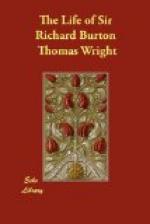’Whene’er indifference
appears, or scorn,
Then, man, despair!
then, hapless lover, mourn!’
for a man versed in the Lila Shastra can soon turn a woman’s indifference into hate, which I have shown is as easily permuted to love.”
This curious book concludes: “May this treatise, Ananga Ranga, be beloved of man and woman, as long as the Holy River Ganges, springeth from Shiva with his wife Gauri on his left side; as long as Lakshmi loveth Vishnu; as long as Brahma is engaged in the study of the Vedas, and as long as the earth, the moon and the sun endure.”
The Kama Shastra Society also issued a translation of the first twenty chapters of The Scented Garden.[FN#406] In reality it was a translation of the French version of Liseux, but it was imperfect and had only a few notes. It has been repeatedly denied that Burton had anything to do with it. All we can say is that in a letter to Mr. A. G. Ellis of 8th May 1887, he distinctly calls it “my old version,"[FN#407] and he must mean that well-known edition of 1886, because all the other impressions are like it, except in respect to the title page.
117. The Beharistan, 1887.
The Society now determined to issue unexpurgated editions of the three following great Persian classics:
The Gulistan or Rose Garden, by Sadi (A.D. 1258). The Nigaristan or Picture Gallery, by Jawini (A.D. 1334). The Beharistan or Abode of Spring, by Jami (A.D. 1487).
The first to appear was The Beharistan in 1887. Jami, the author, is best known in England on account of his melodious poems Salaman and Absal, so exquisitely rendered by Edward FitzGerald, and Ysuf and Zuleika (Joseph and Potiphar’s Wife), familiar to Englishmen mainly through Miss Costello’s fragrant adaptation.[FN#408] To quote from the Introduction of the translation of The Beharistan, which is written in Arbuthnot’s bald and hesitating style, “there is in this work very little indeed to be objected to. A few remarks or stories scattered here and there would have to be omitted in an edition printed for public use or for public sale. But on the whole the author breathes the noblest and purest sentiments, and illustrates his meanings by the most pleasing, respectable, and apposite tales, along with numerous extracts from the Koran.” The work consists of stories and verses— two or three of which will be found in our Appendix—pleasantly intermingled; but as Rehatsek, the translator, made no attempt to give the verses rhythmical form, only an inadequate idea is conveyed of the beauty of the original. It would require an Edward FitzGerald or a John Payne to do justice to Jami’s jewelled verses.
118. The Gulistan, 1888.




